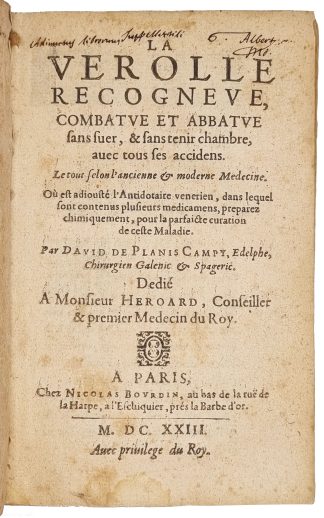PLANIS CAMPY, David de.
SYPHILIS AND GUN WOUNDS
La verolle recogneue. [with] Traicté des playes faites par les mousquetades.
Paris, N. Bourdin, 1623.£2,250.00
FIRST EDITIONS. 8vo. 2 works in 1, separate titles, pp. [32], 189, [5]; II: pp. 271, [3]. Roman letter. Small title vignettes, full-page woodcut of instrument to treat fractures to O6 (II), decorated initials and ornaments, armorial blind stamp to one outer margin. Intermittent light browning (poor paper), slight marginal foxing, a few scattered small ink spots, armorial blind stamp to one outer margin. Good copies in contemporary vellum over boards, ‘Adiunctiis librorum suppellettili Albert[us] Alo(?)’ 1728 to title.
Good copies of the first editions of these important works on syphilis and gun wounds. David de Planis Campy (c.1584-1644) advertised himself as ‘Chirurgien Galenic & Spagiric’, following both ancient medical and iatrochemical theories, i.e., the interpretation and study of medicine and physiology in chemical terms. ‘La verolle recogneue’ is entirely devoted to syphilis, known as ‘Dame Verolle’ (Lady Pox). It suggests that, as stated by Paré, its spreading was caused by the will of God and sexual behaviour, to which it adds astral influences (‘which excite the constellation of the genital parts’) to account for cases preceded by no sexual contact (Poirier, pp.159-60). It begins with a few sections on the causes, symptoms, differences and prognostics of the ‘grosse verolle’, with instructions on its treatment and suitable medicaments. Part II, ‘Antidotaire venerien’, focuses on the detailed preparation of remedies against syphilis, e.g., Guaiac wood, cinnabar, quicksilver oil, arsenic, Mercury balm and liqueur, laudanum (‘take some good opium and let it dry in the sun’), etc. Planis Campy specifies which remedies may also treat other kind of pox or skin ulcers, such as the plague and smallpox (‘petit verolle’), as well as gout. ‘Traicté des playes’ is devoted to wounds caused by muskets and the best ways to treat them, debunking ‘errors’ both theoretical and practical perpetuated by surgeons. The first section provides a short history of the invention of gunpowder, the origins of ‘musket’ and the correct vocabulary to define such wounds (‘Mousquetades’ instead of ‘Arcbusades’, as different ‘bastons à feu’ cause different wounds), whether lead ammunition is poisonous, and how the corruption of the air makes it at times impossible to treat them. The remainder explains how to assess wounds, determine their gravity and diagnosis, with sections on specific remedies, based on Della Porta and Goclenius after Paracelsus, according to type, location on the body, the presence of additional fractures caused by the shot (with a large woodcut illustrating a machine to recompose them), ways to reduce the contextual symptoms of shots, and the best methods to preserve corpses, ‘when the learned and rational surgeon will have done everything in his power’. In the last chapter instructions are given on how to open a body for embalming, with attention to the use of salt: e.g., ‘open the head with a big drill, then empty every bit of the brain, aspirating all the humours and blood with a syringe, then fill with salted water.’
I: Yale, Chicago, JHU and NLM copies recorded in the US. Krivatsy 9066; Wellcome I, 5077. Not in USTC, Osler or Heirs of Hippocrates. II: NLM, Wangensteen, NYAM and Harvard copies recorded in the US. USTC 6027715; Krivatsy 9065; Wellcome I, 5076. Not in Osler or Heirs of Hippocrates. G. Poirier, ‘A Contagion at the Source of Discourse on Sexualities’, in C. L. Carlin (ed.), Imagining Contagion in Early Modern Europe (2005), pp.157-76.In stock





